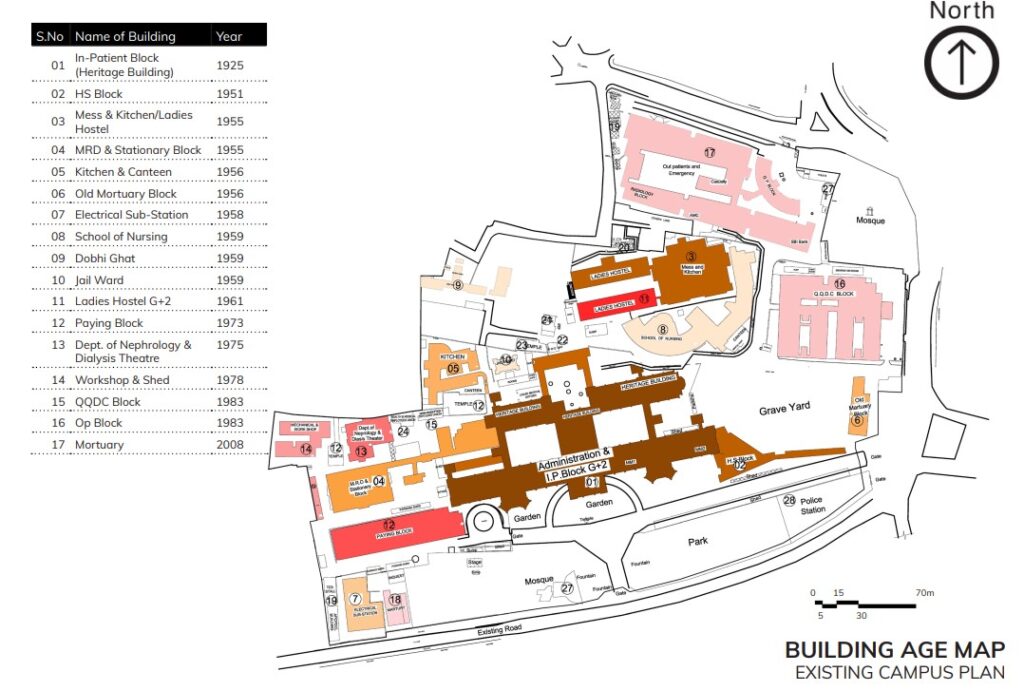
Envisaged as a masterpiece on the Musi riverfront of Hyderabad, Osmania General Hospital was built by Mir Osman Ali Khan, the seventh and last Nizam of Hyderabad State, in 1919. To be created as an ‘ornament to his capital’, the Nizam commissioned British architect Vincent Esch to design the hospital on 26.5 acres of land in his ‘Perpendicular Mogul Saracenic’ architectural style.
Having witnessed a few major medical breakthroughs and served the public healthcare needs for over a century, Osmania General Hospital (OGH) has been facing the threat of demolition. On July 27, 2023, Telangana government filed a counter-affidavit in the High Court in response to several PIL petitions from representatives. Their intent is to demolish the old 29 buildings of OGH and plan a new facility with 1812 beds across the campus, with a hostel facility for post-graduate students, multi-storied car parking, and other requirements such as a mortuary, liquid oxygen facility, laundry, and electric substations.
“Since the old building is situated in the middle of the land parcel, development of alternative hospital is indeed impossible unless this old building was removed. There was consensus that keeping the old building which was not fit for a hospital, at the cost of poor hospital services was inappropriate,” the government affidavit quoted.
Where the government wants to redevelop the overburdened hospital, doctors are arguing that the planned redevelopment will also fall short, and conservationists want to preserve the heritage building which stands as a visual landmark of the city’s culture and identity. In a similar case of demolition of another heritage structure — Errum Manzil Palace, where the then Chief Minister K. Chandrashekar Rao wanted to construct a new building for the Assembly in place of an old palace, the High Court passed a critical judgment. It stated that “it is an imperative duty of the government to protect and conserve its cultural heritage under the World Heritage Convention, 1972 … While it is important to plan for the future, it is equally important to protect, preserve and promote the past.”
The Osmania General Hospital is graded II-B Heritage Building in Hyderabad Metropolitan Development Association (HMDA) listing and is protected under the Heritage Regulations of HMDA, emphasizing its stature.

“This is not just a building but it is the skyline of the city. The entire Musi and the banks of it tell the story of the city and how it took shape,” conservation architect G.S.V. Suryanarayana Murthy, to The Print.
The reports published by INTACH (Indian National Trust for Art and Cultural Heritage) in 2015 and 2019 and by Telangana’s Department of Archaeology and Museums and the Aga Khan Trust for Culture in November, 2019, both suggest the structurally stable condition of the building along with the need for necessary repair and restoration. Both reports state that the hospital building does not need to be demolished.
In an attempt to prevent the annihilation of our heritage, organizations such as Kshetra are exploring options available for hospital expansion by retaining the existing structure. The interventions are focused on complimenting the existing skyline and reflecting the image of Hyderabad city.
“These are markers of identity, these are icons of the past — if you don’t retain that, Hyderabad is no longer a 400-year-old city,” historian and conservation activist Sajjad Shahid, to Caravan.

Featured image: https://newsmeter.in/hyderabad/ogh-demolition-politically-motivated-can-two-structures-co-exist-hyderabad-experts-brainstorm-716069




